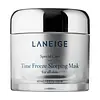What's inside
What's inside
 Key Ingredients
Key Ingredients

 Benefits
Benefits

 Concerns
Concerns

 Ingredients Side-by-side
Ingredients Side-by-side

Water
Skin ConditioningGlycerin
HumectantCyclopentasiloxane
EmollientCyclohexasiloxane
EmollientPropylene Glycol
HumectantCaprylic/Capric Triglyceride
MaskingPolysorbate 60
EmulsifyingDimethicone
EmollientCarbomer
Emulsion StabilisingTriethanolamine
BufferingCetyl Ethylhexanoate
EmollientStearic Acid
CleansingCetearyl Alcohol
EmollientAmmonium Acryloyldimethyltaurate/Vp Copolymer
Sodium Hyaluronate Crosspolymer
HumectantWater
Skin ConditioningPropanediol
SolventAvena Sativa Kernel Extract
AbrasiveGlycerin
HumectantCyclopentasiloxane
EmollientDimethicone
EmollientSqualane
EmollientCyclohexasiloxane
EmollientCeratonia Siliqua Fruit Extract
MaskingHibiscus Abelmoschus Seed Extract
MaskingTillandsia Usneoides Extract
Skin ConditioningAdenosine
Skin ConditioningHydrogenated Lecithin
EmulsifyingC12-16 Alcohols
EmollientGlyceryl Caprylate
EmollientDextrin
AbsorbentDimethicone/Vinyl Dimethicone Crosspolymer
Skin ConditioningDipalmitoyl Hydroxyproline
Skin ConditioningButylene Glycol
HumectantCetearyl Glucoside
EmulsifyingCetearyl Alcohol
EmollientEthylhexylglycerin
Skin ConditioningXanthan Gum
EmulsifyingTheobroma Cacao Extract
Skin ConditioningPalmitic Acid
EmollientPolysorbate 20
EmulsifyingPvp
Emulsion StabilisingPEG-240/Hdi Copolymer Bis-Decyltetradeceth-20 Ether
StabilisingHydroxyethyl Acrylate/Sodium Acryloyldimethyl Taurate Copolymer
Emulsion StabilisingDisodium EDTA
Phenoxyethanol
PreservativeParfum
MaskingWater, Propanediol, Avena Sativa Kernel Extract, Glycerin, Cyclopentasiloxane, Dimethicone, Squalane, Cyclohexasiloxane, Ceratonia Siliqua Fruit Extract, Hibiscus Abelmoschus Seed Extract, Tillandsia Usneoides Extract, Adenosine, Hydrogenated Lecithin, C12-16 Alcohols, Glyceryl Caprylate, Dextrin, Dimethicone/Vinyl Dimethicone Crosspolymer, Dipalmitoyl Hydroxyproline, Butylene Glycol, Cetearyl Glucoside, Cetearyl Alcohol, Ethylhexylglycerin, Xanthan Gum, Theobroma Cacao Extract, Palmitic Acid, Polysorbate 20, Pvp, PEG-240/Hdi Copolymer Bis-Decyltetradeceth-20 Ether, Hydroxyethyl Acrylate/Sodium Acryloyldimethyl Taurate Copolymer, Disodium EDTA, Phenoxyethanol, Parfum
Ingredients Explained
These ingredients are found in both products.
Ingredients higher up in an ingredient list are typically present in a larger amount.
Cetearyl alcohol is a mixture of two fatty alcohols: cetyl alcohol and stearyl alcohol. It is mainly used as an emulsifier. Emulsifiers help prevent the separation of oils and products. Due to its composition, it can also be used to thicken a product or help create foam.
Cetearyl alcohol is an emollient. Emollients help soothe and hydrate the skin by trapping moisture.
Studies show Cetearyl alcohol is non-toxic and non-irritating. The FDA allows products labeled "alcohol-free" to have fatty alcohols.
This ingredient is usually derived from plant oils such as palm, vegetable, or coconut oils. There is debate on whether this ingredient will cause acne.
Due to the fatty acid base, this ingredient may not be Malassezia folliculitis safe.
Learn more about Cetearyl AlcoholCyclohexasiloxane is a type of silicone more commonly known as D6. It is an emollient and solvent.
Cyclohexasiloxane is used to evenly distribute ingredients throughout the product. When applied to the skin, Cyclohexasiloxane evaporates and leaves behind a silky feel.
As an emollient, it can help the skin feel soft and hydrated. It is also used to reduce frizz in hair products.
Learn more about CyclohexasiloxaneCyclopentasiloxane, or D5, is a silicone used to improve texture of products and trap moisture.
D5 is considered lightweight and volatile. Volatile means it evaporates quickly after application. Once evaporated, D5 leaves a thin barrier that helps keep skin hydrated.
It is also an emollient. Emollients help soften the skin and prevent water loss. Silicones create a silky texture in products. D5 helps other ingredients become more spreadable.
Studies show D5 is safe to use in skincare products. We recommend speaking with a skincare professional if you have concerns.
Learn more about CyclopentasiloxaneDimethicone is a type of synthetic silicone created from natural materials such as quartz.
What it does:
Dimethicone comes in different viscosities:
Depending on the viscosity, dimethicone has different properties.
Ingredients lists don't always show which type is used, so we recommend reaching out to the brand if you have questions about the viscosity.
This ingredient is unlikely to cause irritation because it does not get absorbed into skin. However, people with silicone allergies should be careful about using this ingredient.
Note: Dimethicone may contribute to pilling. This is because it is not oil or water soluble, so pilling may occur when layered with products. When mixed with heavy oils in a formula, the outcome is also quite greasy.
Learn more about DimethiconeGlycerin is already naturally found in your skin. It helps moisturize and protect your skin.
A study from 2016 found glycerin to be more effective as a humectant than AHAs and hyaluronic acid.
As a humectant, it helps the skin stay hydrated by pulling moisture to your skin. The low molecular weight of glycerin allows it to pull moisture into the deeper layers of your skin.
Hydrated skin improves your skin barrier; Your skin barrier helps protect against irritants and bacteria.
Glycerin has also been found to have antimicrobial and antiviral properties. Due to these properties, glycerin is often used in wound and burn treatments.
In cosmetics, glycerin is usually derived from plants such as soybean or palm. However, it can also be sourced from animals, such as tallow or animal fat.
This ingredient is organic, colorless, odorless, and non-toxic.
Glycerin is the name for this ingredient in American English. British English uses Glycerol/Glycerine.
Learn more about GlycerinWater. It's the most common cosmetic ingredient of all. You'll usually see it at the top of ingredient lists, meaning that it makes up the largest part of the product.
So why is it so popular? Water most often acts as a solvent - this means that it helps dissolve other ingredients into the formulation.
You'll also recognize water as that liquid we all need to stay alive. If you see this, drink a glass of water. Stay hydrated!
Learn more about Water